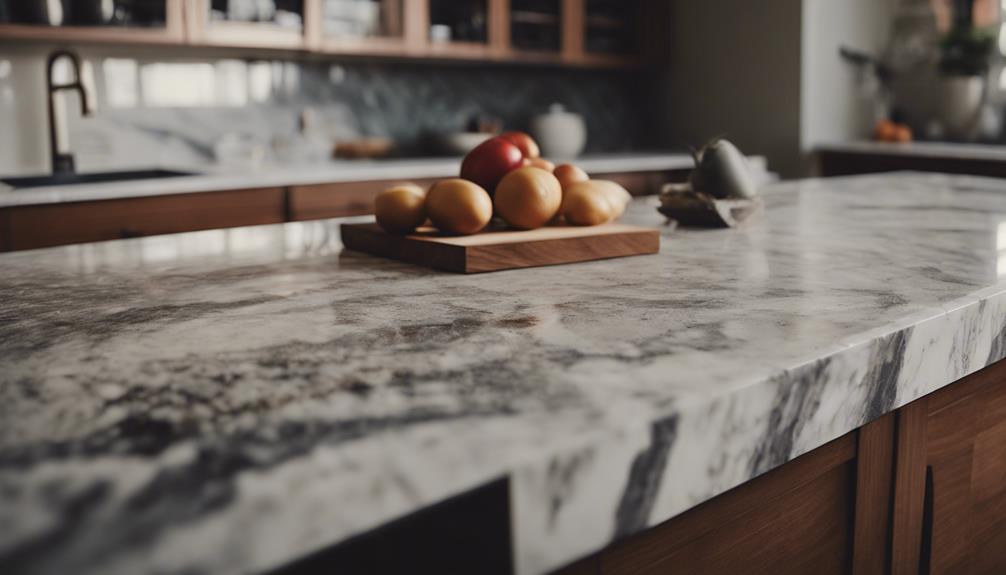Embarking on DIY projects that involve the installation of engineered stone requires a keen understanding of the best techniques for a superior finish. The process, which includes preparing the base, applying adhesive, and positioning the stone, is crucial for a professional-looking outcome. Knowledge of how to expertly grout, seal, and add the final touches significantly elevates a project from good to outstanding. By mastering these methods, DIY enthusiasts can achieve impressive and long-lasting results.
Understanding the nuances of each step, from substrate preparation to the application of finishing touches, is vital for those looking to improve their DIY skills in engineered stone installation. Clear, straightforward guidance on these techniques can help individuals accomplish projects with a level of craftsmanship that mirrors that of professionals. Steering clear of common pitfalls and focusing on quality at every stage ensures that the finished work not only looks exceptional but also endures over time.
Preparing the Substrate
Getting Your Surface Ready
Before you even think about laying down engineered stone, it's crucial to make sure the surface is spotless, bone-dry, and not hiding any bits and bobs. Why? Well, if you want that stone to stick properly and not give you grief later on, this step is non-negotiable. Grab a level and scout out any uneven spots because they'll need sorting out before you go any further. Following what the manufacturer says about getting the substrate ready is key – it's the secret sauce to a fit that lasts.
Choosing the Right Adhesive
Now, when it comes to sticking the engineered stone down, you can't just use any old glue. The manufacturer will recommend a specific adhesive or mortar, and they do that for a good reason. It's all about making sure your stone stays put. And if you're working outside, think about throwing a waterproofing membrane into the mix. It's like an umbrella for your installation, keeping the dreaded damp at bay. By sticking to these steps, you're on track for an engineered stone setup that not only looks the business but lasts ages too.
Getting everything prepped right is the cornerstone of a top-notch engineered stone job. It's not just about making it look good now, but ensuring it stays looking sharp down the line.
Cutting and Shaping Engineered Stone
Cutting Engineered Stone with Precision
When you're aiming for precise cuts on engineered stone, your best bet is to use a wet saw equipped with a diamond blade. This setup ensures you get those clean cuts you're after, without risking damage to the stone. It's a bit like how you'd carefully slice a cake with a sharp knife rather than hacking at it with a blunt one – the right tools make all the difference. On the flip side, dry cutting isn't a great move. It kicks up a lot of dust and could end up doing a number on the stone.
Achieving Intricate Cuts
For those more detailed or curved cuts, whipping out an angle grinder with a diamond blade can be a real game changer. It's a bit more of a finesse job, requiring a steady hand, but the results can be stunning. Keeping safe is non-negotiable, though. Chuck on some goggles and a mask to shield yourself from any flying debris. It's a bit like being a sculptor, where protecting your eyes and lungs comes with the territory.
Prepping for Your DIY Project
Jumping straight into your DIY project without a practice run? Not the best idea. It's like rehearsing a speech. You wouldn't want to wing it without a trial run, right? The same goes here. Grab some scrap pieces of engineered stone and make a few test cuts. This trial allows you to tweak the blade speed and pressure, so when it comes to the real deal, you're all set for success. It's all about getting those settings just right for the task at hand.
Why This Matters
The reason behind all this prep and specific tool use? To make sure you can cut and shape engineered stone with both precision and accuracy. It's not just about getting through the material; it's about doing it in a way that leaves you with a professional-looking finish. Whether you're adding a new countertop or crafting a bespoke piece of decor, the aim is to create something you're proud of, without compromising on the quality or the look of the stone.
Applying Adhesive and Setting the Stone

Ensuring Your Engineered Stone Stays Put
When it comes to fitting your engineered stone, it's all about using a top-notch construction adhesive that's made for the job. This isn't just about sticking something onto a wall—it's about making sure it stays there, looking good for years. So, grab an adhesive that's specifically for stone. It makes a world of difference.
How to Apply the Adhesive Right
First things first, when you're spreading the adhesive on the back of the stone, go for a zig-zag pattern. It might seem a bit odd, but this method ensures the whole surface gets an even coat, which is crucial for a strong bond. Once you've got your adhesive on, it's time to press the stone onto the wall. Don't be shy; apply a good amount of pressure and hold it in place for a few minutes. This step is key because it helps the adhesive start its magic and keep the stone where it should be.
Keeping Things Neat and Tidy
As you're placing each stone, take a moment to check that everything is lined up nicely. You want to avoid a wonky finish! Spacing between stones is another thing to keep an eye on. It's these little details that can make or break the overall look of your project. Plus, sticking to the drying times recommended by the adhesive's manufacturer is vital. It might test your patience, but it ensures that the adhesive has enough time to do its job properly.
| Essential Tips for Success |
|---|
| Use top-tier adhesive for stone |
| Apply adhesive in a zig-zag pattern |
| Always follow the manufacturer's guidelines |
| Ensure proper alignment and spacing |
Choosing the right adhesive and applying it correctly might seem like small steps, but they're actually huge in ensuring your stone installation looks professional and lasts a long time. Remember, it's these foundations that make all the difference to the final result.
Grouting and Sealing
Grouting and Sealing: Essential for Engineered Stone
When it comes to installing engineered stone, the steps of grouting and sealing are not just boxes to tick; they're crucial for ensuring your project looks fantastic and stands the test of time. So, let's break down how to get this right, shall we?
Choosing the Right Materials is a game changer. Go for top-notch grout and sealants that are specially made for stone veneer jobs. This choice makes a world of difference in how your project withstands daily wear and tear.
Getting the Mix Just Right is another key point. Stick to what the manufacturer recommends for mixing grout. It's not just about getting the consistency spot on; it's also about making sure your grout has the muscle to last.
Applying Grout needs a bit of finesse. You want to fill those gaps between stones just right – not too much, not too little. And cleaning up any extra grout quickly helps keep everything looking neat and tidy.
Then, there's the step of Sealing the Grout. Why? Because it's your shield against stains, water damage, and unwanted tiny critters setting up shop in your beautiful stonework. Once the grout has set, get that sealant on to lock in the good and keep out the bad.
Paying Close Attention to Edges is crucial. It's all about making sure no water sneaks through the sides, which could mess with your installation's durability. A well-sealed edge is like wrapping your project in a protective hug.
In all these steps, the aim is to be thorough and thoughtful. Whether it's choosing the right products or applying them with care, each step is about protecting your investment and making sure it looks and performs its best for years to come. Remember, a bit of extra effort now can save you a lot of hassle later on.
Finishing Touches and Maintenance

Maintaining Your Engineered Stone
To keep your engineered stone looking its best, you've got to give it a bit of TLC. This means not just a once-over with a cloth now and then, but really making sure you're doing everything you can to keep it in top condition. The first step is to apply a high-quality sealer. This is crucial because it guards the stone against stains and moisture, which can really spoil its look and shorten its life. Think of it as applying sunscreen to protect your skin – it's all about prevention.
Cleaning Routine
When it comes to cleaning, simplicity is key. A gentle detergent mixed with water is your best friend here. This combination is perfect for getting rid of everyday dirt and grime without being too harsh on the stone. And here's a pro tip: use a soft brush or cloth when you're cleaning. Why? Because anything abrasive could leave scratches, and no one wants that. It's all about being gentle but thorough.
Inspection and Care
Now, just like you'd check your car regularly for any issues, the same goes for your engineered stone. Keep an eye out for any signs of damage or wear. If you spot anything, sort it out quickly. The sooner you deal with small problems, the less chance they have to turn into big ones. And just like your car might need an oil change, your stone might need a bit of a touch-up with sealer. Doing this every one to three years will keep it looking fresh and protected, depending on how much wear and tear it sees.
Product Tips
When it comes to buying the products you need, like sealers and detergents, head to your local home centre. They'll have everything you need. And when you're applying products like sealant, make sure to cover the entire surface evenly. It's all about giving your stone the best protection possible.
In essence, looking after engineered stone isn't rocket science. It's about regular cleaning with the right products, protecting it with a sealer, and dealing with any issues as soon as they pop up. Do all this, and your engineered stone will stay looking good as new for years to come.
Conclusion
Using the 5 Best DIY Engineered Stone Installation Techniques, you can transform your home into a beautiful, stone-clad haven without breaking the bank. Imagine turning your living space into a warm, inviting area with a stunning stacked stone veneer fireplace as its centrepiece or enhancing your garden with elegant stone pathways. These techniques offer a lightweight and cost-effective alternative to real stone, making your DIY project more manageable and enjoyable.
By carefully preparing the surface, precisely cutting and shaping the engineered stone, applying the right adhesive, setting the stone in place, filling the gaps with grout, and sealing it all to protect against the elements, you'll be amazed at what you can achieve. It's like crafting your masterpiece, where each stone is a brushstroke that adds to the beauty of your home.
However, we know that some projects might seem a bit daunting at first. That's where Allstone Solutions comes in. If you find yourself in need of assistance, whether it's for Granite Installations, Marble Installations, CNC Stone Engraving, or just seeking more information on Engineered Stone Installation and Maintenance, don't hesitate to Contact Us. We're here to help your vision come to life.
And if you're ready to take the next step in transforming your home with the elegance of engineered stone, request a quote from us. We at Allstone Solutions are committed to providing you with the expertise and materials you need to make your DIY project a success. Let us be part of your journey in enhancing your living space with the timeless beauty of stone.















